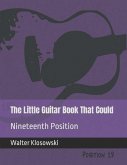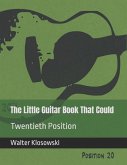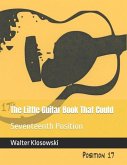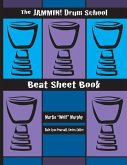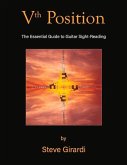This LITTLE GUITAR BOOK THAT COULD showcases the popular C A G E D guitar chord and scale sequence exclusively in the EIGHTEENTH POSITION for all to see, use and reference. But before thumbing through this book, there exists some important subject matter that the guitarist may need reminding of...even though he or she may have played for years. In this book, six is the exact number of consecutive frets involved in the EIGHTEENTH POSITION, and it spans a musical two octaves plus a perfect fourth when in standard tuning. Moreover when in the EIGHTEENTH POSITION or any other position, the second and third fingers on the fretting hand remain stationary in their respective frets or "slots", generally speaking, as their stationary qualities allow the first and or fourth finger to accomodate the notes found in the outer fret areas. For the picking hand, there is a very important string pattern best picked near the sound hole or bridge where that hand happens to reside nearly all the time. This pattern involves every other string, and is best evidenced when the C A G E D main root note sequence is plucked alphabetically, starting with the C root on the first or thinnest guitar string. To best understand, start by picking the C there on the first string, fretted with the third finger, then move to the D (third string, second finger); then E (fifth string, second finger); G (second string, third finger); A (fourth string, second finger) and conclude with the C (sixth string, third finger). The one-three-five-two-four-six string pattern naturally fits the picking hand, it being every other sting, plus the pattern is looped forwards or backwards (six-four-two-five-three-one) as the C root notes found on the first /sixth string(s) are deemed interchangeable. The three musical terms used in this book that need clarification are main root notes, octaves and unisons. What are main root notes? Generally speaking, main root notes represent a specific set of core root notes that fall or cluster under the second and third fingers of the fretting hand, and in the EIGHTEENTH POSITION, all C A G E D main root notes make use of the the second and third fingers only. Once the location of each main root note is memorized the attention then moves to their octaves as found in the outer frets. An octave is defined as the interval between one musical pitch and another with half or double its own frequency. Some correctly call the interval a "perfect octave", and in guitarland, octaves are usually "one string one fret away". This handy fact helps memorize their location even though, occasionally, two strings and or two frets are involved (the same concept applies in that there will be some sort of string skipping). Next, and perhaps a bit unrelated, are unisons, which often occur in guitar positionwork. Unisons are simply defined as when two or more music notes happen to sound the same pitch. In guitarland, it usually means "same note different string or fret". And very importantly, the term also implies that the unison itself occurs in the current guitar position. This LITTLE GUITAR BOOK concludes with an A B C D E F G A alphabetical appendix, in which the C A G E D material is thus reorganized alphabetically to include the B and F material. And even there the book's uncomplicated, straightforward "picture worth a thousand words" format allows one to take full musical advantage of the material straight away. You'll have fun discovering some fresh perspectives on the same old appraoches, while also adding some new twists and turns to your own technique. And to top it off, this LITTLE GUITAR BOOK THAT COULD concludes with copious amounts of manuscript and fretboard paper too, making it an ideal musical guitar journal of sorts. To close, thank you very kindly for welcoming THE LITTLE GUITAR BOOK into your library of fretboard knowledge needs...Enjoy!
Hinweis: Dieser Artikel kann nur an eine deutsche Lieferadresse ausgeliefert werden.
Hinweis: Dieser Artikel kann nur an eine deutsche Lieferadresse ausgeliefert werden.


